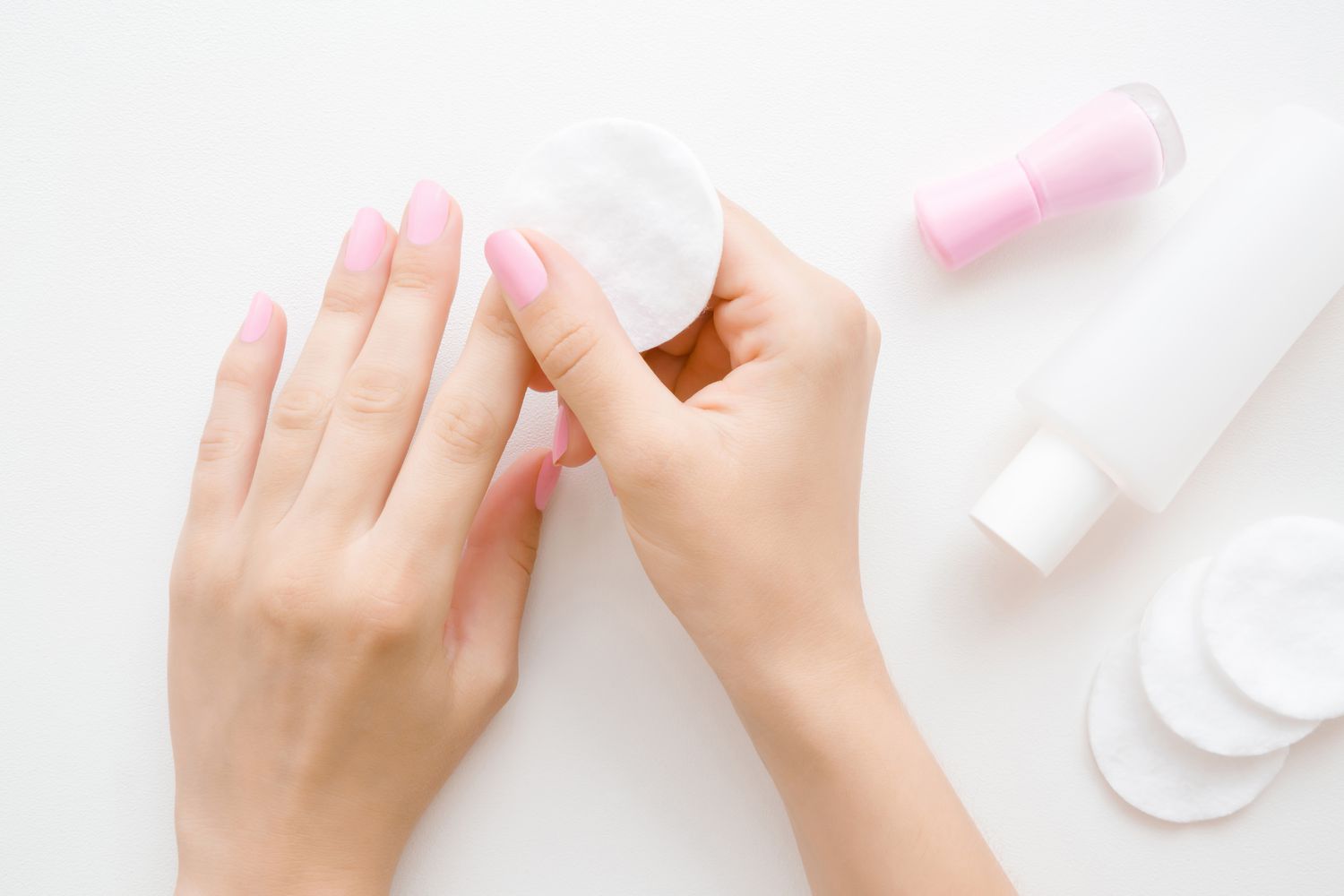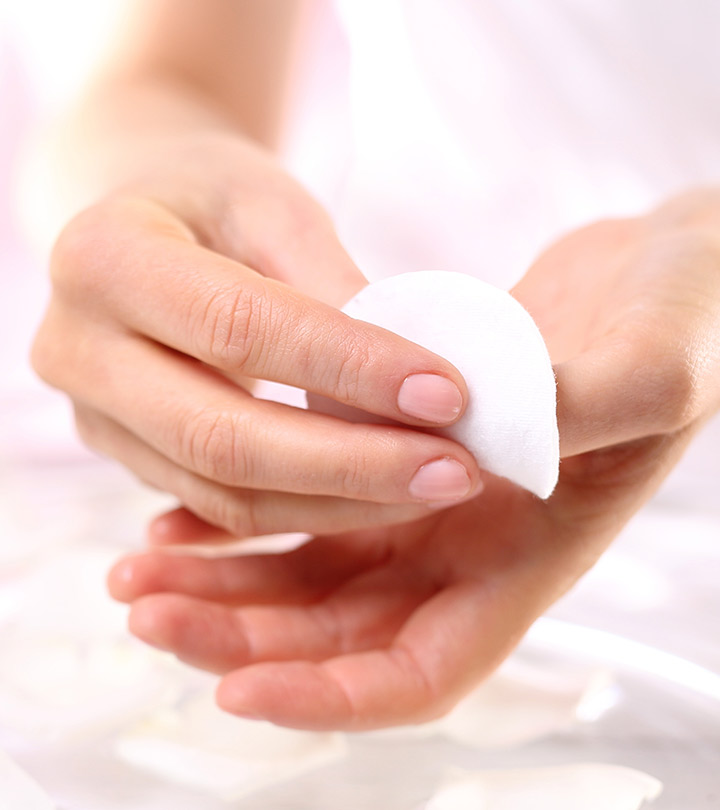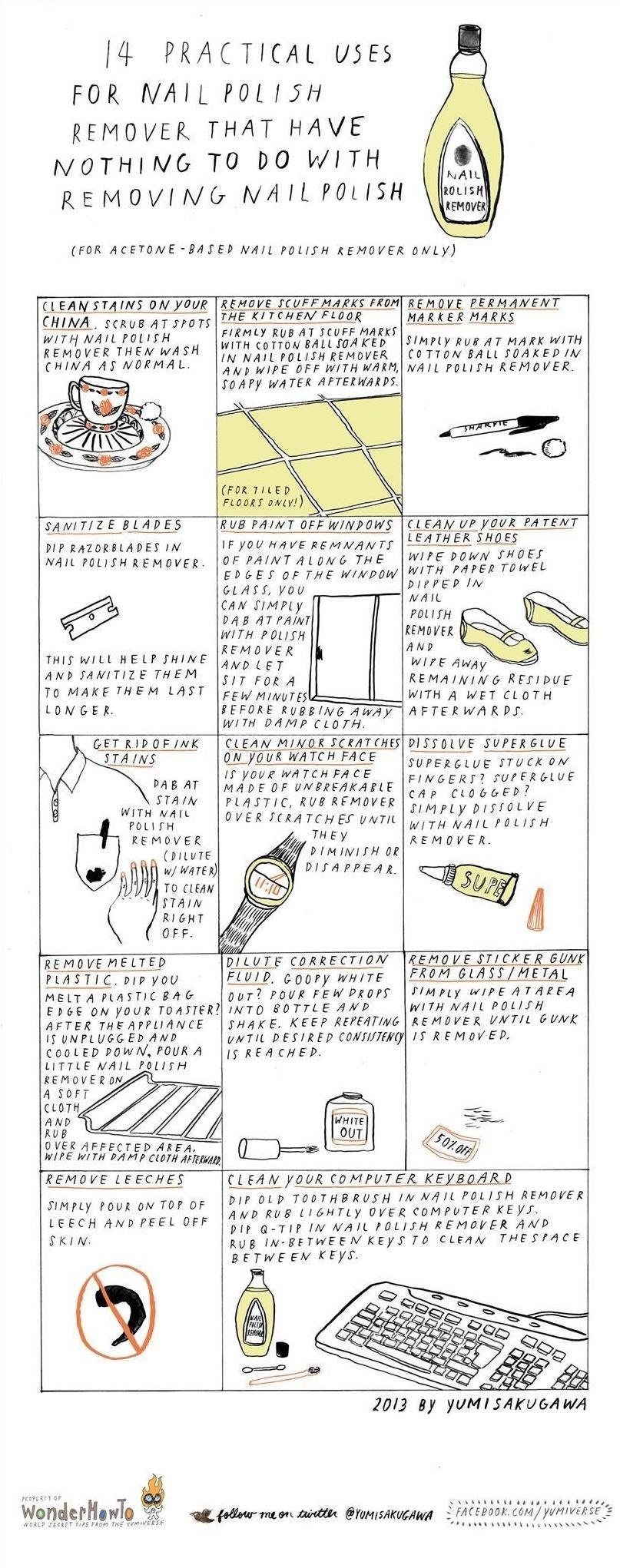Introduction

When it comes to removing stubborn paint stains, many individuals often turn to alternative solutions such as nail polish remover. Despite its primary use for removing nail polish, this widely available product has the potential to effectively remove certain types of paint as well. In this article, we will explore the uses of nail polish remover beyond its conventional application and examine its efficiency in removing different types of paint stains. By understanding the composition and chemical properties of nail polish remover, as well as considering specific factors and precautions, we can utilize this versatile product for various cleaning purposes.
Background Information On Nail Polish Remover And Its Main Purpose
Nail polish remover is a commonly used product that is specifically designed to remove nail polish from fingernails and toenails. It is typically composed of solvents, such as acetone or ethyl acetate, which work to dissolve the nail polish and make it easier to remove. The main purpose of nail polish remover is to effectively and efficiently remove nail polish without damaging the nails. It is a convenient and practical solution for those who regularly wear nail polish and need to change colors or remove chipped polish.
Can Nail Polish Remover Remove Paint?
Yes, nail polish remover can remove paint. The main ingredient in nail polish remover is acetone, which is effective in breaking down various types of paint, including latex-based paint, enamel paint, and uncured paint. To remove paint, simply pour a small amount of nail polish remover onto a cotton ball or soft rag and gently lift off the paint drips or overspray using light pressure. However, it’s important to proceed with caution and test the remover on a small, inconspicuous area first to ensure it doesn’t damage the surface.
Understanding Nail Polish Remover

Nail polish remover is a common household product used primarily for removing nail polish. It is composed of chemicals, with acetone being the primary ingredient. Acetone is a powerful solvent that can break down nitrocellulose and synthetic resin, which are the main components of nail polish. Nail polish removers are available in various formulations, including acetone-free options. They are designed to effectively dissolve and remove nail polish from nails. However, due to its chemical properties, nail polish remover can also be used to remove other substances, such as paint, from different surfaces.
Composition Of Nail Polish Remover And Its Chemical Properties
Nail polish remover consists primarily of acetone, a powerful organic solvent. Acetone works by breaking down nitrocellulose and synthetic resin, the main components of nail polish. Alongside acetone, nail polish removers may also contain additional ingredients such as oils, fragrances, and moisturizers. However, acetone is the key ingredient responsible for the efficient removal of nail polish. Due to its strong chemical properties, acetone can dissolve various substances, including paint and adhesives. It is important to note that acetone can be harsh on the skin and nails, so caution should be exercised when using nail polish remover.
Different Types Of Nail Polish Removers Available
There are different types of nail polish removers available in the market. The most commonly used type is acetone-based nail polish remover, which is known for its effectiveness in removing stubborn nail polish. Acetone-free nail polish removers are also available, which are considered to be gentler on the nails. Additionally, there are nail polish remover pads and wipes that provide convenience and ease of use. Some nail polish removers also include moisturizing ingredients to help keep the nails and cuticles hydrated. It is important to choose a nail polish remover that suits your needs and preferences.
Uses Of Nail Polish Remover

Nail polish remover, with its powerful acetone-based formula, has various uses beyond just removing nail polish. It can efficiently remove stains and marks from hard surfaces like countertops, floors, and walls. The acetone in the remover breaks down the paint, making it easy to wipe away. Additionally, it can be used to clean and sanitize tools and utensils, such as paintbrushes and scissors. Some people even use nail polish remover to remove sticky residue from labels and stickers. However, it’s important to use nail polish remover in a well-ventilated area and avoid contact with the skin.
Removing Nail Polish Efficiently
When it comes to removing nail polish, nail polish remover is the go-to solution. Its acetone-based formula effectively breaks down the polish, making it easy to wipe away. To remove nail polish efficiently, follow these steps:
- Apply a small amount of nail polish remover onto a cotton ball or pad.
- Press the soaked cotton ball onto the nail and hold it in place for a few seconds.
- Gently rub the cotton ball in a circular motion to loosen the polish.
- Continue to wipe the nail until all the polish is removed.
Remember to wash your hands thoroughly after using nail polish remover to prevent any residue from lingering on your skin.
Removing Stains And Marks From Hard Surfaces
Nail polish remover is a versatile solution for removing stains and marks from hard surfaces. Its acetone-based formula effectively breaks down stubborn stains and marks, making it ideal for surfaces like tile, laminate, and concrete floors. Simply apply a small amount of nail polish remover onto a cloth or paper towel and gently rub the stained area. The solvent properties of the remover help dissolve and lift the stain, leaving the surface clean and mark-free. However, it’s important to avoid using nail polish remover on wood surfaces, as it may cause damage.
Removing Paint With Nail Polish Remover

Removing paint with nail polish remover is a convenient and effective method. To remove paint, start by applying a small amount of nail polish remover onto a clean cloth or cotton ball. Gently rub the painted surface in a circular motion, applying slight pressure. The acetone in the remover helps to dissolve the paint and loosen its bond with the surface. Continue rubbing until the paint starts to lift off. If necessary, repeat the process until the desired results are achieved. However, it’s important to note that nail polish remover may damage certain surfaces, so it’s always best to test it in a small, inconspicuous area first.
Factors To Consider When Using Nail Polish Remover To Remove Paint
When using nail polish remover to remove paint, there are a few factors to consider. Firstly, it is important to test the nail polish remover in a small, inconspicuous area to ensure it does not damage the surface. Additionally, nail polish remover should be used in a well-ventilated area to avoid inhaling the fumes. It is also advisable to wear gloves to protect the skin from the harsh chemicals in the remover. Finally, it is crucial to follow the instructions on the nail polish remover bottle and to avoid using excessive force when rubbing the painted surface to prevent any damage.
Effectiveness On Different Types Of Paint
Nail polish remover can be effective in removing certain types of paint, but its effectiveness may vary depending on the type of paint you are dealing with. Here are some factors to consider:
- Oil-based paint: Nail polish remover may be less effective in removing oil-based paint because oil-based paints are generally more resistant to solvents.
- Latex paint: Nail polish remover can be effective in removing latex paint from surfaces. However, it is important to test it in an inconspicuous area first to avoid any damage.
- Acrylic paint: Nail polish remover can be quite effective in removing acrylic paint from surfaces. Acrylic paint is water-based and can be easily dissolved by the solvents in nail polish remover.
It is important to note that the effectiveness of nail polish remover may also depend on the age and thickness of the paint.
Precautions And Tips

To ensure safe and effective use of nail polish remover for paint removal, it is important to follow these precautions and tips:
- Ventilation: When using nail polish remover, make sure you are in a well-ventilated area to avoid inhaling the fumes.
- Skin protection: Wear gloves to protect your skin from the harsh chemicals in the remover.
- Test in a small area: Before applying nail polish remover to a larger area, test it on a small, inconspicuous area to ensure it does not damage the surface.
- Avoid excessive scrubbing: Instead of aggressive scrubbing, let the nail polish remover sit on the paint for a few minutes to help loosen it.
- Clean residue: After removing the paint, clean the area with soap and water to remove any residual nail polish remover.
Remember to refer to the product’s instructions for specific usage recommendations and safety precautions.
Safety Measures To Follow When Using Nail Polish Remover
When using nail polish remover, it is important to follow these safety measures to ensure your well-being:
- Ventilation: Always use nail polish remover in a well-ventilated area to avoid inhaling the fumes.
- Skin protection: Wear gloves to protect your skin from the harsh chemicals in the remover.
- Eye protection: Use safety goggles or glasses to prevent any splashes or drips from getting into your eyes.
- Test in a small area: Before applying the remover to a larger area, test it on a small, inconspicuous area to check for any adverse reactions or damage.
- Safe disposal: Dispose of used nail polish remover properly according to local regulations.
By following these precautions, you can safely and effectively use nail polish remover for paint removal.
Alternative Methods For Removing Paint
In addition to using nail polish remover, there are alternative methods for removing paint. These methods include using paint strippers, heat guns, sandpaper, and scraping tools. Paint strippers are chemical solutions that help break down and dissolve paint, while heat guns soften the paint so it can be easily scraped off. Sandpaper can be used to sand away layers of paint, and scraping tools can be used to physically remove paint from surfaces. It is important to follow safety precautions and instructions when using these alternative methods.
Conclusion

In conclusion, nail polish remover can be an effective solution for removing certain types of paint stains. Its efficiency varies depending on the type of paint and surface being treated. While it may work well for removing small paint splatters or stains on hard surfaces, it may not be as effective for larger areas or certain types of paint. It is always important to test a small hidden area before applying nail polish remover to larger surfaces. Additionally, alternative methods such as paint strippers, heat guns, sandpaper, and scraping tools can also be explored for more stubborn paint removal.
Summary Of Findings
Nail polish remover can be an effective solution for removing certain types of paint stains. Its efficiency varies depending on the type of paint and surface being treated. It works well for removing small paint splatters or stains on hard surfaces. However, it may not be as effective for larger areas or certain types of paint. It is always important to test a small hidden area before applying nail polish remover to larger surfaces. Alternative methods such as paint strippers, heat guns, sandpaper, and scraping tools can be explored for more stubborn paint removal.
Exploring Other Potential Uses Of Nail Polish Remover
Nail polish remover has various potential uses beyond its primary purpose. It can be used to remove adhesive residue, such as leftover sticker or tape marks. It can also help remove ink stains from surfaces or clothing. Additionally, nail polish remover can act as a degreaser, effectively removing grease or oil stains. It can even be used to clean dirty keyboard keys or other small electronic components. However, caution must be exercised when using nail polish remover on delicate or sensitive materials, as it can cause damage.
Frequently Asked Questions about Essie Nail Polish
1. Is Essie nail polish good?
Yes, Essie nail polish is highly regarded by many nail enthusiasts around the world. Known for its extensive range of colors and quality formulas, Essie has become a go-to brand for both professionals and individuals who want beautiful, long-lasting nail color.
2. What sets Essie nail polish apart from other brands?
One of the key factors that sets Essie apart is its exceptional formula. The polish is known for its smooth application, even coverage, and quick drying time. Additionally, Essie offers an extensive color range, allowing you to find the perfect shade for any occasion or personal preference.
3. How long does Essie nail polish last?
The longevity of Essie nail polish can vary depending on several factors like your nail health, application technique, and usage habits. Generally, Essie nail polish lasts for about 5 to 7 days without chipping or losing its shine when applied properly and paired with a good base and top coat. However, results may vary from person to person.
4. Does Essie nail polish require multiple coats?
The number of coats needed for Essie nail polish largely depends on the color intensity you desire. Most Essie shades offer excellent pigmentation, and one coat can often provide adequate opacity. However, applying two coats is usually recommended for a more vibrant and even color payoff.
5. Is Essie nail polish easy to apply and remove?
Yes, Essie polish is generally easy to apply due to its smooth consistency and brush design. The brand’s wide, rounded brush allows for precise application and covers the nail easily with each stroke. When it comes to removal, Essie nail polish can be taken off using regular nail polish removers without much effort.
6. Can I use Essie nail polish if I have sensitive nails?
While Essie nail polishes are formulated to be gentle on the nails, individual sensitivities may vary. If you have sensitive nails or are prone to nail damage, it’s always a good idea to perform a patch test before applying any new nail polish. This will help you determine if Essie is suitable for your specific nail needs.
7. Where can I purchase Essie nail polishes?
Essie nail polishes are widely available for purchase. You can find them at beauty supply stores, drugstores, online retailers, and Essie’s official website. It’s always a good idea to check with authorized sellers to ensure you are purchasing genuine Essie products.
8. Is Essie a cruelty-free brand?
Yes, Essie is a cruelty-free brand. They do not test their products on animals, and they have a strict policy against animal testing. Additionally, Essie nail polishes do not contain any animal-derived ingredients, making them suitable for vegans as well.
9. Can I use Essie nail polish if I’m pregnant?
Essie nail polishes are considered safe to use during pregnancy as they do not contain any harmful ingredients like formaldehyde or toluene. However, it is always recommended to consult with your healthcare provider or doctor for personalized advice regarding the usage of any beauty products during pregnancy.
10. Is Essie nail polish worth the price?
Many people consider Essie nail polish to be worth the price due to its quality formula, extensive color range, and overall brand reputation. While it may be pricier than some drugstore brands, the consistent performance, durability, and wide variety of shades make Essie a popular choice for nail polish enthusiasts worldwide.
In conclusion, Essie nail polish is highly regarded for its quality formula, extensive color range, and ease of application. Whether you are a professional manicurist or an individual seeking beautiful, long-lasting nail color, Essie is a brand that can deliver on both quality and style.

I am proud to offer non-toxic beauty options. The gel polishes I offer are “9-Free”, free of nine of the most commonly found allergens and toxic chemicals in nail polish, and cruelty-free, vegan, and HEMA-free. The nail lacquers I offer range between “7-Free” and “16+-Free” and are also cruelty-free and vegan.